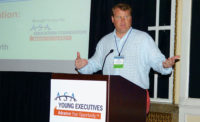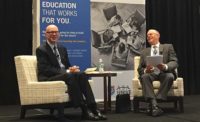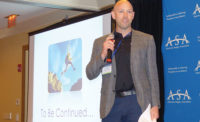If you sell or buy products, you likely fall into one of four patterns: You’re a driver, an artist, a manager or an engineer, said Robb Best of Elkay Mfg. Co. He spoke May 19-20 at the American Supply Association’s Spring Forum ’14 and Young Executives meeting in Milwaukee.
In his two-part presentation, “Neuroscience and Sales,” Best told the 129 attendees how they could use brain science to present and sell their products. Drivers, he said, want to be assertive and in control whether they are selling or buying. Artists value the visual qualities of a product over the mechanical. Managers want a sales process with very defined steps. Engineers want to know the construction and details of a product.
“The average closing ratio in our industry is 28.5,” Best said. “That means you lose three of four customers. You try to sell everyone the same way. The best salespeople change their selling style to fit the customer’s buying pattern.”
While salespeople in the plumbing industry like to say this is a relationship business, that’s not the case with most customers, he added. Drivers seek the best deal and engineers want to know how a product performs. Only managers and, to a lesser extent, artists value their relationship with a salesperson.
Best, Elkay’s senior adviser of cognitive strategy, also debunked the commonly held notion that talent is more important than mindset in determining sales success. Mindset is more powerful, and people possess either a fixed or an open mindset.
A fixed mindset, he explained, sees a predetermined world where skills are considered gifts and people either have talent or they don’t. A growth mindset sees a world where people can grow incrementally with practice and hard work.
In making sales presentations, Best encouraged ASA members to incorporate as many of the following 10 “power words” as possible: You, safe, discover, new, love, health, results, save, proven and guaranteed. He shared this advice on selling as well:
- Information on demand is the best way to honor your customer. People remember only three things about your product. Tell your customer three key things about your product. If they request more information, give them more.
- Long meetings are a waste of time. After 40 minutes, the brain needs to reboot for 20 minutes.
- First impressions are more powerful than we know. Always smile when you meet someone for the first time. An added benefit is that you will make yourself feel better when you smile.
- Barriers create barriers. Your chances of selling drop 40% if you are sitting across the desk from a customer. It’s better to be sitting alongside.
- Utilize choice isolation. If you present too many choices to your customer, you lower the quality of the decision being made. The brain is binary, so it can choose only one of two selections. Give your customer two choices at one time, and then move on by positioning the winning selection with the next choice.
The Young Executives and other attendees also heard from Mark-Hans Richer, senior vice president and chief marketing officer for Harley-Davidson, who discussed marketing his brand. Timothy Jahnke, president and CEO of Elkay, and Timothy Ferry, president of InSinkErator, shared their thoughts on leadership at different points of the conference. InSinkErator hosted a tour of its plant in Racine, Wis., on May 21.






